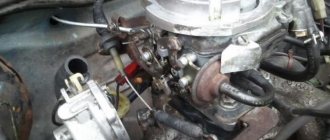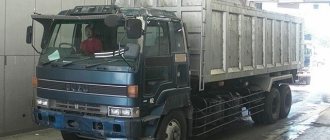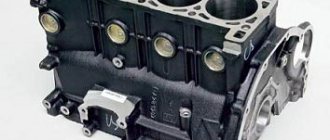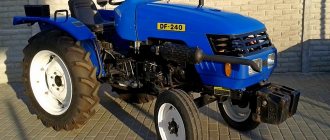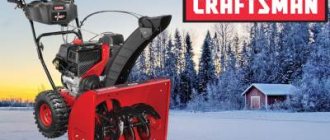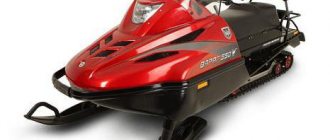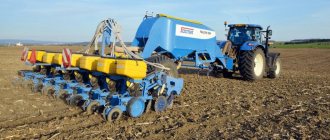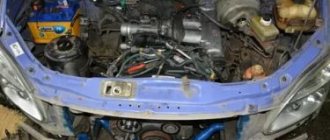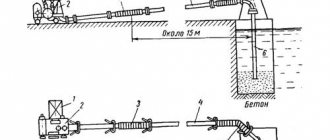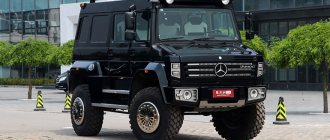Three in one. That's what a Mercedes-Benz Unimog is. A powerful truck on a universal chassis platform, with the capabilities of a mobile workshop or search and rescue vehicle. This family of German versatile all-terrain trucks can work on the quiet streets of small towns, in impassable village mud. As well as other extreme conditions by climatic standards or other criteria.
The Unimog (short for Universal motor gerät) was originally developed for post-war agricultural use with high wheels and ground clearance, as well as four-wheel drive.
The goal was high maneuverability on different terrain, including off-road, and not carrying capacity. Subsequently, versatility and cross-country ability made it possible for Daimler-Benz AG to produce various Unimog models. Equipped with dozens of types of special equipment.
First.
0
There were a large number of orders for Mercedes Unimogs; the car was even ordered from Europe for military purposes. The manufacturer simply could not cope with such volumes. At this time, Daimler-Benz began to take a closer look at the production of cars. In 1951, the concern acquired the rights to manufacture the Unimog, and large-scale production began at the Gaggenau plant. In the same year, the manufacturer released the Unimog 2010 model. From a thousand units in 1951, production increased by the next year to almost four thousand cars. It is curious that although the Unimog was produced as a Mercedes brand car, it had its own logo on the hood: the letter “U” in the form of a bull’s head. Only in the mid-50s did the three-pointed Mercedes star appear on the radiator grille of new models.
Prices
The cost of the Unimog 405 series ranges from 13 million rubles and above, and the heavier 4000-5000 (“thousandths”) are a little cheaper.
For quality, for which even the Japanese have not come up with alternatives, you have to pay. The used version is cheaper and can be found on the secondary market for less than 2,000,000 rubles. It is also possible to try your luck on Western trading platforms. In Western Europe you can find a car for ridiculous money, but customs clearance is expensive. This is also a very good car, although not new. Another question is that if problems arise, you will have to struggle with finding spare parts.
Mercedes Benz Unimog is worth purchasing if you want to have a reliable assistant in off-road conditions and all urban elements. Yes, it is not cheap, but it is worth considering that with each set of equipment you are essentially purchasing a new car.
It's him. At the parade.
0
At the beginning of 1961, the fifty thousandth Unimog truck rolled off the assembly line. By this time, Unimogs gained fame as universal all-terrain vehicles. They are used not only as agricultural and military transport, but also as assistants in urban utilities. Gradually, engine power increases to 32 and 34 hp. In 1963, Unimog introduced the Unimog U406 series with a four-sided attachment feature. The first Unimogs of this series were produced with a powerful six-cylinder engine of 65 hp. — during production, the power increased to 110 hp. The wheelbase was 2380 mm. The second generation Unimogs became typical representatives of the brand: in 1966, Mercedes Unimogs reached the mark of 100 thousand units. The expansion of the model range begins: the plant assembles U34, U40, U70, U80, as well as Umimog S, intended for civilian use. Unimogs are becoming more powerful and larger.
Modifications
Today's lineup includes three main lines.
- Episode 437. The “heaviest” episode. Includes U4000 and U5000 models for off-road use. They differ in maximum load and configuration - the Mercedes-Benz Unimog U4000 has turbocharged diesel engines with 177 and 218 hp, while the U5000 has only 218 hp. In addition, the 5000 has more ground clearance (476-490 mm versus 434-438 mm for the 4000), and as a result, even higher cross-country ability. However, it will cost you about 20 thousand euros more.
- Episode 405. Middle episode. It serves as the base for all kinds of utility and special machines. Engines are 177 turbodiesels and the most powerful of the Unimogs - inline six 238 hp. working volume 6374 cm3.
- U20. Light urban series, almost never found in Russia.
Cars of the 437 series can be equipped with a kung, a flatbed body or a “hunter’s house on wheels”. They can also be equipped with a double cab.
But the list of configurations for the average 405 series is truly huge. This:
- Dump trucks;
- Truck cranes;
- Aerial platforms;
- Vacuum cleaning machines;
- Snow removal machines;
- Fire trucks;
- Light armored cars;
- Police cars;
- Airfield tractors;
- Tankers;
- Rotary mowers and agricultural attachments that turned the car into a self-propelled harvester;
- And even railway chassis.
Unimog U406
0
A tilting cab, power steering, pneumatic brake booster, and the ability to use Unimogs as mini-locomotives thanks to the addition of a railway mode (additional wheels for the railway track are installed on the car) appear. The light series was continued by such models as the U54 (type 403) with a wheelbase of 2250 mm and the U40 (type 421) with a wheelbase of 2380 mm. The variety of attachments for the Unimog makes it an indispensable all-rounder for utilities. The number of modifications, both serially and to order, is constantly growing. Since 1970, Unimogs with an open cockpit have been equipped with safety frames.
average cost
The price of used cars depends on the technical condition, level of equipment and year of manufacture. For example, copies produced in the 60s and 70s. will cost the buyer up to 750 thousand rubles, the U-416 modification, assembled in the early 80s, has a price tag of up to 1.2 million rubles. The price of new generation cars exceeds 10 million rubles. (determined based on negotiations with the dealer), used copies will cost less. For example, the cost of a 5-year-old U5000 Wagon flatbed truck is within 6 million rubles.
Unimog U403
0
Since 1973, Mercedes Benz has been introducing another new product to the market called MB Traс - a tractor assembled on the Unimog platform. Despite the great popularity and active sales of trucks, in the agricultural world the result was slightly lower than what the manufacturer expected. MB Trac was supposed to fix the situation in the tractor segment. All-wheel drive like the Unimog, the MB Trac had four wheels of the same size, but a more recognizable tractor design - an angular, high cab located between the axles. The use of disc brakes and high technology Unimog made this model revolutionary at the time. During production until 1991, the tractor improved its modifications and was used not only in agriculture, but also in forestry.
Interior
Inside the cabin, the first thing to admire is the huge 4-spoke steering wheel with 2-way VarioPilot controls. Large, the size of an average computer monitor, adjustable dashboard mounted on the dashboard. In rotary switches that regulate the temperature in the cabin, its airflow, and so on.
To the right of the steering wheel, occupying the entire space from the dashboard to the rear wall of the cabin, including the space between the seats. There is a large control unit for the truck systems, mainly of the key type. Two large and comfortable chairs with the same Mercedes stitching.
Nothing superfluous, everything is spartanly simple and pragmatic, but, as always with Mercedes-Benz, it looks very good and elegant. For ease of climbing on separately located steps with an anti-slip coating, there is a vertical support handle on the inside of the doors.
Which visually divides the front part of the side glass into two parts (almost the entire height of the windshield), which also looks very good (the second part of the side glass is ordinary square).
MB Traс
0
In 1974, production of the 425, “heavy” type was launched (models Unimog U1300, U125 and others). They were united by such technical characteristics as a 2810 mm wheelbase, power up to 125 hp. and a carrying capacity of about 9 tons. At the end of the 70s, the Unimog appeared in a new design with an enlarged cabin, which turned out to be a good decision. Unimogs are still produced in this form, with minor changes. The shape changed from round to angular. Power increased to 168 hp. All Unimogs from Mercedes were equipped with disc brakes on both the front and rear wheels. The gearbox has become eight-speed with the ability to increase the number of steps to 16. And the letter L appeared in the name of Unimog models, which meant an extended wheelbase.
Model range in the table
Unimog models are usually divided into several series:
- early generations 401/402 and improved 411, produced until 1975;
- the first version with all-wheel drive 404, which lasted on the assembly line until 1980;
- the 406 family (including models 416, 426, 419, 403, 413, 421 and 431), which were assembled until the early 90s;
- light series LBU (407 and 408);
- medium MBU series (417 and 418);
- heavy series SBU (424, 425, 435 and subsequent - 427, 436 and 437);
- series for extreme road conditions 437.4, produced in the 2000s.
First generation
The first generation is usually understood as the LBU, MBU and SBU series, assembled in the 90s. last century.
The characteristics of the machines are given in the table.
| Parameter | 408 | 418 | 427 |
| Length, m | up to 5.07 | up to 5.623 | up to 6.1 |
| Width, m | 1,912 | 2,096 | 2,3 |
| Height, m | up to 2.59 | up to 2.67 | 2,875 |
| Base, m | 2.69 or 3.22 | 2.83 or 3.9 | from 3.25 to 3.85 |
| Turning radius, m | 11.2 or 13.3 | 12.0 or 13.85 | — |
Second generation
The characteristics of the machines are given in the table.
| Parameter | U216 | U323 | U427 | U530 long |
| Wheelbase, mm | 2800 | 3000 | 3150 | 3900 |
| Permissible total weight, t | 10,0 | 13,8 | 14.0 | 16,5 |
| Turning diameter, m | 12,6 | 13,7 | 14.3 | 16,9 |
| Length, m | 4,9 | 5,1 | 5,15 | 6,2 |
| Width, m | 2,15 | 2,2 | 2,2 | 2,3 |
| Height, m | 2,82 | 2,9 | 2,9 | 2,97 |
| Maximum speed, km/h | 89 | 89 | 89 | 89 |
In addition, special regional Unimog models are produced.
For example, the U20 modification differs in the use of a shortened wheelbase and a diesel engine from the Accelo truck, produced in Brazil.
The equipment is supplied to the markets of developing countries with left-hand traffic.
Unimog U437
0
At the beginning of the new century, Unimog celebrates its 50th anniversary with new models in the range: U300, U400 and U500, medium-heavy trucks that have received the greatest recognition in the field of road and municipal services. And in 2002, the heavy Unimog series was replenished with chassis with increased cross-country characteristics - U3000, U4000, U5000, presented at the Hannover Truck Exhibition. Unimog production in Germany is moving to the city of Werte, but in 2011 it will go even further - to the KamAZ plant, where the first Unimog in Russia is rolling off the assembly line.
Exterior
The front appearance of all MB Unimogs is unique - it is quite large (for the Unimog U 400 - 2.15 m * 1.15 m), a carbon fiber cabin with a sunroof and nameplates on the doors, a huge curved windshield, a small sharply sloping hood, with a huge three-beam a star in the middle and a powerful two-tier front bumper.
Upon external examination, it is almost impossible to distinguish the Unimog of the thousandth series U4000 from the U5000. Since they are like twins, they have the same size, exterior and interior. The 100th series Unimog U 400 and U500 are externally different from the 1000th series in terms of platform length.
Unimog U500 Black Edition from Brabus.
0
Even such a hard worker suits an expensive suit.
In the summer of 2011 in Russia, at the joint enterprise of the German concern Daimler AG and KamAZ OJSC, Mercedes-Benz Trucks Vostok (MBTV), the assembly of special vehicles - Unimog all-terrain trucks - began. The first model assembled at the plant in Naberezhnye Chelny was the Unimog U400 locomobile, intended for road and municipal services. The Unimog is assembled in Russia using the large-knot method (SKD), from kits from the Daimler AG plant located in the city of Werth.
The unique Mercedes-Benz Unimog
Three in one. That's what a Mercedes-Benz Unimog is. A powerful truck on a universal chassis platform, with the capabilities of a mobile workshop or search and rescue vehicle. This family of German versatile all-terrain trucks can work on the quiet streets of small towns, in impassable village mud. As well as other extreme conditions by climatic standards or other criteria.
The Unimog (short for Universal motor gerät) was originally developed for post-war agricultural use with high wheels and ground clearance, as well as four-wheel drive.
The goal was high maneuverability on different terrain, including off-road, and not carrying capacity. Subsequently, versatility and cross-country ability made it possible for Daimler-Benz AG to produce various Unimog models. Equipped with dozens of types of special equipment.
Unimog U400 with railway rollers.
0
Unimogs have always been distinguished by a wide range of capabilities, had excellent movement and high cross-country ability. The car is adapted for VIP residences and hunting lodges. Unimogs achieved high cross-country ability and quality of work performed due to many features. • High ground clearance, on some models up to 40 cm. • Modern Unimogs, which started with low power, are equipped with four and six-cylinder turbodiesel engines delivering up to 280 hp. power. There are also modifications with gasoline engines. • Due to its features, the flexible ladder-type frame can withstand large bending loads, increases the turning angle of the car, due to the expansion in the rear, it allows the installation of a large body, and also resists lateral roll when driving. • Permanent all-wheel drive and disc brakes. • U-shaped (portal, gear) axles allow you to increase the truck's ground clearance, and the increased number of gearboxes reduces the load on the transmission. High torque is important for towing and driving at low speeds, but in addition to this, by distributing the load between gears, high reliability of the design is achieved. • Telescopic shock absorbers and coil springs increase the track width. In extreme off-road conditions, this allows for full wheel-to-ground contact. • Single tires instead of double tires used on similar trucks. Improves road grip with low rolling resistance. Tire pressure is adjusted by the driver directly from the cab, allowing it to be relieved instantly in soft ground conditions. • The ability to install attachments on all four sides on the Unimogi has made it a true legend in the world of household equipment. It is capable of performing any agricultural, road, utility and industrial work. • The presence on modern models of an anti-lock braking system and adjustment of the braking force as the load increases. These two systems guarantee Unimog stability and effective braking. • Dual-mode travel, installed on some models, allows you to move both on the road and along the railway track. • The Unimog tilting cabin is made of artificial materials and is not subject to corrosion. The interior is equipped with LCD displays and an electronic instrument panel, luggage compartments and necessary tools. From the outside, the cabin has a wide viewing angle.
0
0
0
0
0
0
Despite its utilitarian nature, the Unimog also proved to be a good athlete. In 1984, the famous Paris-Dakar rally was won in the truck category by the Lalle-Durs crew in a Mercedes Unimog. Another Unimog, number 503, came second. And these trucks still perform in rallies and raids.
0
0
Engine and gearbox
The truck is equipped with three turbodiesel engines: a 4-cylinder in-line OM 904 LA (4249 cm3, 177 “horses”), a 6-cylinder in-line OM 906 LA with a volume of 6374 cubic centimeters and a power of 238 horsepower, and a 4-cylinder in-line OM 924 LA ( 4800 cm3, 218 hp)
Another distinctive feature of the Mercedes-Benz Unimog is the absence of reverse gear. Instead, an additional reverse gearbox is installed. That is, in each gear, this car is capable of moving both forward (if the gearbox is in direct gear) and backward (with reverse engaged).
Russian analogues
In the USSR, and then in Russia and the CIS countries, several models of cars were produced that were conceptually close to the Unimog:
- Army GAZ-66, equipped with a V-shaped gasoline engine and permanent drive on all axles. The driver can increase cross-country ability by bleeding air from the tires. The Russian analogue is equipped with a 4-speed gearbox and an additional 2-speed gearbox, its load capacity is 2 tons. The vehicle was assembled in small batches at the Ukrainian KrAZ plant (it has no external or design differences from its Russian analogues).
- Chassis Ural-43206, characterized by the use of a cab with a hood arrangement. This design provides an increased level of protection against landmines or mines (the vehicle was developed by order of the military). The truck is equipped with a ladder frame, the transmission includes a 5-speed manual transmission and a 2-speed transfer case. The car is designed for driving on paved roads and off-road. The vehicle is not suitable for towing wagons.
Fuso trucks based on Unimog
The Fuso brand trucks produced by Daimler Kamaz Rus have nothing to do with the Unimog platform and were created by the design bureau of the Mitsubishi concern. The basic chassis has a load capacity of 7.5 or 8.55 tons, and it is possible to install flatbeds or vans for transporting commercial cargo or food products. The assembly of the universal Unimog equipment has been discontinued due to the low popularity of the machine.
All-wheel drive truck Silant
The Silant machine was developed by NAMI designers based on a number of solutions borrowed from Unimog. Assembly is carried out in small batches (for example, from 2009 to 2015, only 500 copies were shipped). The equipment has an increased load capacity of up to 4.5 tons. The plant installs MMZ, Cummins or YaMZ diesel engines with a power of up to 155 hp. pp., working in conjunction with a SAAZ or ZF manual transmission. The cars produced differ in wheelbase. There are modifications of the car and tractor, differing in wheels and travel speed.

